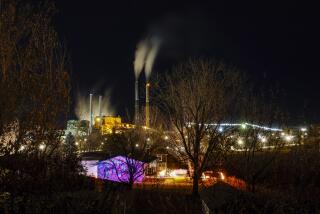In Hanna, Tough Times Come and Go
- Share via
HANNA, Wyo. — June 30, 1903: The blast hurled massive support timbers hundreds of feet, and smoke belched from Mine No. 1.
For a week, the fire raged deep while townspeople searched furiously for survivors. Few were found.
“Of those who were recovered, the awful events of the few moments following the explosion drove many insane and they fought like demons against their rescuers,” read the next day’s Cheyenne Daily Leader.
At least 169 men died in one of the nation’s worst mining disasters.
The fire was eventually snuffed out, the debris cleared and the mine reopened. But it took five years and another blast that killed 58 for the lucrative and accursed No. 1 to be sealed for good.
For better or worse, richer and poorer, Hanna has been married to coal from the beginning. Now that Wyoming’s last underground coal mine has closed in Hanna, and the town’s other coal mine is scheduled to close next year, it could be that death do them part.
There are no other major or even medium-sized employers in this remote town of about 1,000.
Wyoming coal mining began just southeast of present-day Hanna in 1868. The boomtown of Carbon, home to 2,000 people at its peak, sprang up around the first two coal mines along the Transcontinental Railroad.
When the Carbon mines closed in 1889, most residents left and founded Hanna, where new mines had opened. Carbon became a ghost town; Hanna, a company town.
“You could be born in a company hospital and buried in a company casket, that kind of thing,” said Nancy Anderson of the Hanna Basin Historical Society.
Hanna was a melting pot of cultures. English, Welsh, Italian, Finnish and other immigrants lived in tiny houses built in neat rows with water pumps at the end of each street. The Finns, the town’s largest ethnic group, moved their little church from Carbon and built a community hall.
Union Pacific gave out mining instruction books that doubled as reading and English language primers. Each lesson had photographs that darkly illustrated the consequences of not obeying the rules.
Frozen dynamite should be thawed in manure, not with a lantern. And never empty pipe ashes on a box of explosives.
Company-sponsored social events kept the miners and their families occupied on the lonesome prairie. Baseball was popular, and it was not unusual for the company to hire men more for their playing ability than for their mining skills.
As in the infamous Appalachian company towns, it was easy for miners to rack up debt at the company store. One man killed in the 1903 explosion owed half his $40 post-mortem paycheck to Union Pacific, including a $1 medical bill.
The old mines snaked directly under the town, and present-day residents are sometimes haunted by dark holes that suddenly open in parking lots.
In the 1950s, the old mines closed when Union Pacific changed from steam engines to diesel locomotives and the railroad no longer needed coal.
For a time, logging in Medicine Bow National Forest to the south helped keep Hanna alive. Then came the coal boom of the early 1980s. Mines opened in the hills just north of town, including two surface mines.
The population surged again. Trailers and homes repopulated the town. A $3-million recreation center was built.
But coal prices have been falling ever since. Some mine employees have been laid off, others transferred. People have been moving to greener pastures.
The remaining residents point with some hope to retirees moving to Hanna in search of inexpensive living, but there is little promise of an economic revival soon.
More to Read
Sign up for Essential California
The most important California stories and recommendations in your inbox every morning.
You may occasionally receive promotional content from the Los Angeles Times.










